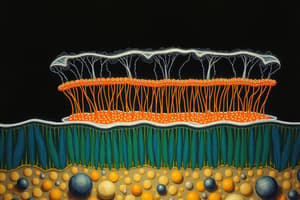Podcast
Questions and Answers
What is the primary function of the sodium-potassium pump?
What is the primary function of the sodium-potassium pump?
- To enable the synthesis of ATP from ADP
- To transport calcium ions into the cell
- To facilitate the movement of glucose across the membrane
- To maintain the resting potential of the cell (correct)
How does ATP influence the sodium-potassium pump?
How does ATP influence the sodium-potassium pump?
- It is hydrolyzed to drive the movement of potassium ions into the cell
- It binds directly to sodium ions to facilitate their exit
- It directly alters the permeability of the cell membrane
- It donates a phosphate group to the pump, allowing sodium ions to be expelled (correct)
What is the correct stoichiometry of ion exchange for the sodium-potassium pump?
What is the correct stoichiometry of ion exchange for the sodium-potassium pump?
- 3 sodium ions in, 2 potassium ions out
- 1 sodium ion in, 3 potassium ions out
- 3 sodium ions out, 2 potassium ions in (correct)
- 4 sodium ions out, 1 potassium ion in
What happens to the pump after sodium ions have been released to the extracellular fluid?
What happens to the pump after sodium ions have been released to the extracellular fluid?
What is the end result of the sodium-potassium pump's activity on membrane potential?
What is the end result of the sodium-potassium pump's activity on membrane potential?
Flashcards are hidden until you start studying
Study Notes
Sodium (Na+) and Potassium (K+) Pump Overview
- The sodium-potassium pump is essential for maintaining cell membrane potential.
- Operates by exchanging sodium (Na+) and potassium (K+) ions across the cell membrane.
- Conforms to the ratio: 3 sodium ions are pumped out of the cell, and 2 potassium ions are pumped in.
Mechanism of Action
- ATP is the energy currency utilized for the pump's operation; one molecule of ATP is consumed per cycle.
- Phosphate is transferred from ATP to the pump protein (phosphorylation), enabling shape change that facilitates ion movement.
Phosphorylation Process
- The three Na+ ions bind to the pump, triggering phosphorylation.
- This phosphorylation alters the pump's configuration, allowing Na+ to be released into the extracellular fluid (ECF).
- The pump then opens to the outside, creating binding sites for K+ ions.
Potassium Ion Entry
- The pump contains two specific binding sites for K+.
- K+ ions enter the cell after the conformational change caused by the binding of phosphate.
- Once K+ is bound, the phosphate group is released, restoring the pump to its original configuration, which facilitates the release of K+ into the cell.
Importance for Cellular Function
- The activity of this pump is crucial for establishing the negative resting potential within the cell.
- Disruption of Na+/K+ pump function can lead to imbalances affecting cell excitability and communication.
Studying That Suits You
Use AI to generate personalized quizzes and flashcards to suit your learning preferences.




